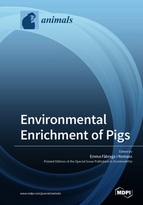Environmental Enrichment of Pigs
A special issue of Animals (ISSN 2076-2615). This special issue belongs to the section "Pigs".
Deadline for manuscript submissions: closed (28 February 2019) | Viewed by 58970
Special Issue Editor
Interests: pig welfare; damaging behaviour (tail, ear biting); sustainable pig production; precision farming and welfare
Special Issues, Collections and Topics in MDPI journals
Special Issue Information
Dear Colleagues,
The limitation to fulfil ethological and physiological needs can negatively affect animal welfare and cause the development of abnormal behaviour. Pigs have a strong motivation to perform exploratory and foraging behaviour from a very young age, even if they are provided with enough feed to satisfy their dietary needs. Tail-biting is a redirected behaviour said to be a response to insufficient stimulation and frustration in association with other negative environmental and management factors. Although the exact triggering mechanisms remain unclear, tail-biting has a multifactorial origin, and the scientific evidence has identified a wide range of environmental, dietary, and husbandry risk factors. The lack of adequate enrichment material appears to be an initial risk factor that may trigger stress and has been considered a major cause for the most common type of tail biting, the so-called two-stage tail biting, which starts with gentle manipulation of another pig’s tail and proceeds to more intensive manipulation with the teeth, causing bleeding and damage. Therefore, tail biting becomes not only an important welfare concern, but it also has serious economic consequences for pig producers, because it lowers weight gains and increases susceptibility to secondary infections, antibiotic use, and carcass condemnations. Up to now, tail docking is the most widely preventive measure against tail biting adopted by farmers, although it is considered to cause acute pain, and it does not totally prevent tail biting, since it does not address the underlying causes. The EU legislation of pig welfare does not allow routine tail docking unless other measures such as environmental and management conditions have been tackled. Moreover, EU legislation specifically states that “pigs must have permanent access to a sufficient quantity of material to enable proper investigation and manipulation activities”. However, provision of adequate enrichment materials is not easy in modern intensive production systems, since a lot of them use either totally or partially slatted floors. There is a certain mismatch between those materials that are meaningful for pigs to fulfil their behavioural needs (i.e., straw-type materials) and those that do not cause any blockage to the slurry systems (i.e., object-type materials). Therefore, an important challenge for researchers is to deliver data and practical solutions on enrichment materials with attributes that satisfy pigs’ needs, that is, being manipulable, investigable, safe, edible, and chewable, but suitable to be implemented in intensive production systems. The aim of this Special Issue is to collate recent research on “enrichment materials for pigs”, tailored to different climatic conditions and pig production systems.
We invite original research papers that address new insights on enrichment materials for pigs or on how to implement those materials on commercial farms. Topics of special interest include: effects of enrichment material on welfare, pig handling responses, and productivity; effectiveness of enrichment materials to avoid tail biting; adequate enrichment materials for all production stages; carry-over effects of enrichment materials provided during the early development stage; a cost-benefit analysis of providing enrichment materials; and overcoming practical barriers to implement enrichment materials. Additional topics may include practical strategies to evaluate the effectiveness of enrichment materials on farms and strategies to communicate and increase farmers’ involvement in the use of enrichment materials as a mean to avoid tail docking.
Dr. Emma Fàbrega i Romans
Guest Editor
Manuscript Submission Information
Manuscripts should be submitted online at www.mdpi.com by registering and logging in to this website. Once you are registered, click here to go to the submission form. Manuscripts can be submitted until the deadline. All submissions that pass pre-check are peer-reviewed. Accepted papers will be published continuously in the journal (as soon as accepted) and will be listed together on the special issue website. Research articles, review articles as well as short communications are invited. For planned papers, a title and short abstract (about 100 words) can be sent to the Editorial Office for announcement on this website.
Submitted manuscripts should not have been published previously, nor be under consideration for publication elsewhere (except conference proceedings papers). All manuscripts are thoroughly refereed through a single-blind peer-review process. A guide for authors and other relevant information for submission of manuscripts is available on the Instructions for Authors page. Animals is an international peer-reviewed open access semimonthly journal published by MDPI.
Please visit the Instructions for Authors page before submitting a manuscript. The Article Processing Charge (APC) for publication in this open access journal is 2400 CHF (Swiss Francs). Submitted papers should be well formatted and use good English. Authors may use MDPI's English editing service prior to publication or during author revisions.
Keywords
- enrichment material
- pig
- welfare
- tail biting
- tail docking
- exploratory behaviour







